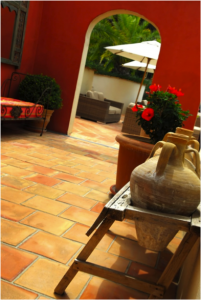 In long-ago times pots were used to store seeds, wine, medicines, and whatever people needed to keep contained. Most of these pots were hardened in a fire and remained unglazed. The terra cotta colors seen here in these pots and tiles are actually the tones of the original clay pulled from the earth.
In long-ago times pots were used to store seeds, wine, medicines, and whatever people needed to keep contained. Most of these pots were hardened in a fire and remained unglazed. The terra cotta colors seen here in these pots and tiles are actually the tones of the original clay pulled from the earth.
Today’s tile choices are so much more varied – in design, size, color and use. Glazes allow us to create almost any color and design. Sophisticated manufacturing methods keep tiles very similar in size and easy to install. However, there is a real value to going back to the original feel of pottery when creating a special space.
This outdoor patio takes full advantage of the patina of old-style clay in its design. The unglazed tile floor demonstrates a wide variety of color and tone. The tiles themselves are uneven and imperfect squares. Natural toned grout has a wider application, allowing the variations in size and shape the leeway to fit the space.
design. The unglazed tile floor demonstrates a wide variety of color and tone. The tiles themselves are uneven and imperfect squares. Natural toned grout has a wider application, allowing the variations in size and shape the leeway to fit the space.
Two different types of tile pots decorate the space. The classic red clay pots hold rosemary in the corner and a red hibiscus on the right. These pots have everything needed to keep plants going – holes for drainage and plenty of space for supporting soil. This is a good way to bring living plants onto a patio, softening the area.
Further toward the front on the right, the older pots play a purely decorative role. Unglazed and with a patina that looks to have come from age, they bring this outdoor space into another time. The old wood frame and simple pots can handle the weather, but they also serve as a rustic element – setting a tone and moving the space beyond standard manufactured choices.
How about mixing old and new? Let some pieces that bring back the memory of how pottery started join the newest tile options in your own home.
